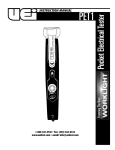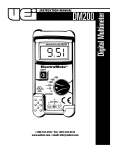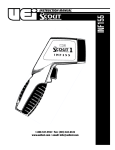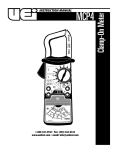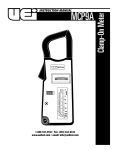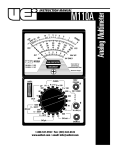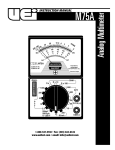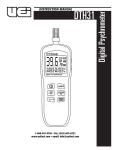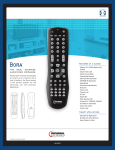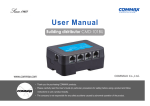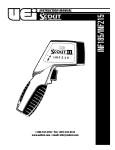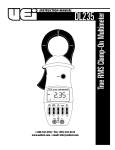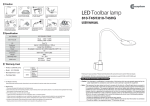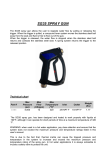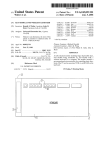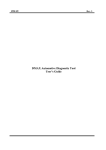Download INSTRUCTION MANUAL
Transcript
INSTRUCTION MANUAL DM5B 1-800-547-5740 • Fax: (503) 643-6322 www.ueitest.com • email: [email protected] Introduction The DM5B digital multimeter is a pocket sized, hand held, battery operated, voltage, current and continuity measurement instrument. It provides the accuracy and numerous functions typically found in full sized multimeters. Features include • 750 Volts AC & DC • 5 Amps AC & DC • Continuity • Resistance to 30 • Megohms • Autoranging • Analog bar-graph • Data hold • Fuse protected current ranges Safety Notes Before using this meter, read all safety information carefully. In this manual the word "WARNING" is used to indicate conditions or actions that may pose physical hazards to the user. The word "CAUTION" is used to indicate conditions or actions that may damage this instrument. • Always follow industry standard safety practices including protective clothing, gloves and safety glasses when appropriate • Do not attempt to measure any voltage that exceeds 1000 volts AC or DC with this meter. • Do not attempt to use this meter if either the meter or the test leads have been damaged. Turn it in for repair at a qualified repair facility • Ensure meter leads are fully seated by making a quick continuity check of the leads prior to making voltage measurements • Keep your fingers away from the test lead’s metal probe contacts when making measurements. Always grip the leads behind the finger guards molded into the probes • Use a current clamp adapter when measuring current that may exceed 10 amps. See the accessories in UEi’s full-line catalog • Do not open the meter to replace batteries or fuses while the probes are connected DM5B-MAN WARNING! Exceeding the specified limits of this meter is dangerous and can expose the user to serious or possibly fatal injury. • Always turn off power to a circuit (or assembly) under test before cutting, unsoldering, or breaking the current path Even small amounts of current can be dangerous • Always disconnect the live test lead before disconnecting the common test lead from a circuit • In the event of electrical shock, ALWAYS bring the victim to the emergency room for evaluation, regardless of the victim’s apparent recovery - Electrical shock can cause an unstable heart rhythm that may need medical attention • Higher voltages and currents require greater awareness of physical safety hazards - Before connecting the test leads; turn off power to the circuit under test; set the meter to the desired function and range; connect the test leads to the meter first, then to the circuit under test. Reapply power • If any of the following indications occur during testing, turn off the power source to the circuit under test: • Arcing • Flame • Smoke • Extreme Heat • Smell of Burning Materials • Discoloration or Melting of Components CAUTION! Do not attempt to remove the meter leads from the circuit under test. The leads, the meter, or the circuit under test may have degraded to the point that they no longer provide protection from the voltage and current applied. If any of these erroneous re a d i n gs are observed, disconnect power immediately and recheck all settings and connections. International Symbols P. 1 Operating Instructions V: Volts Ω: Ohms : Resistor (schematic symbol) : Continuity mode (4.1 kilohertz tone) : Diode (schematic symbol) mA: Milliamps DC or AC 5A: Five Amp DC or AC Meter Lead Connections WARNING! Grip leads behind finger guards when making measurements. The meter leads will be connected in this manner regardless of the measurement: Connect the black test lead to the terminal marked “COM” and the red test lead to the terminal marked “V/mA/A/Ω”. DC/AC Voltage Measurement WARNING! Electric shock, instrument damage, or equipment damage may result if input voltages exceed 1000 Volts DC or AC RMS. Do not attempt to take any unknown voltage measurement that may be in excess of 1000 Volts DC or AC RMS. 1. Set the rotary switch to the “V” function (DC V or AC V). The meter will default to the voltage source, press the “DC/AC” push-button to switch to AC. The meter indicates which mode you have selected at the far left of the display. 2. Touch the probes to the circuit under test and read the display. NOTE: If the input voltage exceeds this meter’s range the indicator will display the overload symbol “O.L.”. If a negative DC voltage is being measured the “-” symbol will appear on the left side of the display. Resistance Testing Ensure your circuit is isolated from other circuit paths to prevent testing the wrong path. The DM5B can measure up to 30 megohms. 1. Set the function switch to the resistance position “Ω/ “ and note the overload symbol “O.L.” on the display. Megohms “MΩ” is displayed in the lower right. 2. Touch the red lead to one side of the circuit (i.e. resistor) and the black lead to the other side and read the display. Continuity Testing 1. Set the function switch to the Continuity/Diode position “ / “. The continuity symbol “ “ will be displayed in the upper left of the display, the overload symbol “O.L.” in the center, and ohms “Ω“ in the lower right. 2. Touch the red lead to one side of the circuit (i.e. wire) and the black lead to the other side. If the circuit resistance is approximately 20 ohms or less a continuous tone will sound, indicating continuity. Diode Testing 1. Set the function switch to the Continuity/Diode position “ / “. 2. Press the “ / “ push-button immediately below and to the left of the LCD. The diode symbol “ “ will be displayed in the lower left of the display, the overload symbol “O.L. “ in the center, and volts “V” in the upper right. 3. Isolate the diode from other circuit components, and connect the red test lead to the diode, and the black to the other. A black band is normally printed around the end of the cathode side of the component. Note the displayed value. 4. Reverse the red and black test leads and again note the displayed value. If the reading in the first (forward biased) direction indicates some measurable value and the reading in the reversed direction shows an overload “O.L.” the diode is good. If the displayed value is low, or even measurable, in both directions, the diode is probably shorted. If the display indicated an overload “O.L.” in both directions, the diode is probably open. Some diodes, however, require a higher biasing voltage than this meter supplies. See UEi’s catalog to purchase an economical high-power diode test lead adapter set if necessary. Amperage Measurement CAUTION! The resistance, continuity and diode modes are protected to a maximum of 500 volts. To avoid personal injury or damage to the instrument, do not make measurements in these modes when open circuit voltage may exceed 500 volts DC or AC. WARNING! The current functions are protected by a 150 volt rated fuse. To avoid personal injury or damage to the instrument, do not measure current sources having open circuit voltage greater than 250 volts DC or AC. Current measurements are made in SERIES with the circuit (or circuit element) under test. NEVER CONNECT THE TEST LEADS ACROSS A VOLTAGE SOURCE when an amps measuring position is selected. This can cause damage to the circuit under test or this meter. DM5B-MAN P. 2 To measure current, you must break the circuit under test (cut a wire for example) and make the meter part of the circuit. This creates two connection points. On one side is the power source and the other is the load. If DC current is being measured, a minus sign will be displayed when current is flowing opposite to the connection polarity. 1. Ensure power is off to the circuit to be tested. 2. Set the rotary switch to the mA or 5A position (depending on the maximum possible amperage you will be measuring). The meter will default to the DC current setting. If you have an AC current source, press the “DC/AC” push-button to switch to AC. Th meter i n d i cates which mode you have selected at the far left of the display. 3. Create a break in the circuit as described earlier and connect the meter leads to the two points created at the break. 4. Apply power to the circuit and note your measurement value. WARNING! Do not remove the leads from the circuit until power is disconnected. Battery and Fuse Replacement When the battery icon appears in the upper right of the display, the batteries must be replaced immediately. Low battery voltage can cause incorrect readings and consequential damage. 1. To replace the batteries, remove the meter from its carrying case. 2. Slide the battery cover plate (on the back of meter) out. 3. Replace both batteries at once with type listed in the specifications. 4. Reassemble the meter. Fuse Replacement WARNING! Replace fuses with the type listed in the specifications (also printed on the circuit board) only. 1. To replace the fuses, remove the meter from its ca r rying case. 2. Slide the battery cover plate out (on the back of meter). 3. Remove the three back panel retaining screws and separate the two halves. Maintenance Periodic Service 4. Locate and replace expended fuse. • 5A near the bottom • .5A near the middle 5. Reassemble the meter. WARNING! Repair and service of this instrument is to be performed by qualified personnel only. Improper repair or service could result in physical degradation of the meter. This could alter the protection from electrical shock and personal injury this meter provides to the operator. Perform only those maintenance tasks that you are qualified to do. These guidelines will help you attain long and reliable service from your meter: • Calibrate your meter annually to ensure it meets original performance specifications • Keep your meter dry. If it gets wet, wipe dry immediately Liquids can degrade electronic circuits • Whenever practical, keep the meter away from dust and dirt that can cause premature wear • Although your meter is built to withstand the rigors of daily use, it can be damaged by severe impactsUse reasonable caution when using and storing the meter Specifications NOTE: Accuracy is stated as ± (% of reading + number of least significant digits) at 32 to 104˚F, with relative humidity up to 80%. Stated accuracy is valid for a period of one year after calibration. AC conversions of this meter are average responding and calibrated to the RMS value of a pure sine wave input. DC Voltage Range Resolution Accuracy 300 mV 0.1 mV ±(1.2% + 2 digits) 3V .001 V ±(0.5% + 2 digits) 30 V .01 V ±(1.2% + 2 digits) 300 V .1 V 750 V 1V ±(1.5% + 3 digits) Resolution Accuracy Protections 1000 V AC Voltage Cleaning Periodically clean your meter’s case using a damp cloth. DO NOT use abrasive, flammable liquids, cleaning solvents, or strong detergents as they may damage the finish, impair safety, or affect the reliability of the structural components. Range 3V .001 V 30 V .01 V 300 V .1 V 750 V 1V Protections ±(2.0% + 3 digits) 1000 V ±(2.0% + 4 digits) Clean the input terminals as follows: 1. Turn the meter off and remove all test leads. 2. Shake out any dirt that may be in the terminals. 3. Soak a new swab with alcohol and work the swab around in each terminal. DM5B-MAN P. 3 DC Current Range Resolution 30 mA .01 mA 300 mA .1 mA 5A .01 A Accuracy Protections ±(1.5% + 2 digits) 500 mA, 250 V ±(2.5% + 3 digits) 5 A, 250 V AC Current Range Resolution 30 mA 10 mA 300 mA 100 mA 5A Accuracy Protections ±(2.0% + 4 digits) 500 mA, 250 V 10 A ±(3.0% + 4 digits) 5 A, 250 V Range Resolution Accuracy Protections 300 0.1 3K 1 30 K 10 ±(1.2% + 3 digits) 500 V 300 K 100 3M 1K 30 M 10 K Resistance ±(3.0% + 5 digits) Diode Test Resolution Max Current Max Voltage Protection 0.8 mA 3.3 V 500 V 1 mV Continuity Frequency 4.1 K Hz tone when <20 Ω ± 10 Ω, Protected to 500 V Feature Summary Maximum voltage between any 750 V terminal and earth ground Digital display 3-3/4 digits, 3200 counts with automatic polarity indication Input impedance 10 Meg Ohms Storage temperature 14˚ to 122˚F (-10˚ to 50˚C) Operating temperature 32˚ to 104˚F (0˚ to 40˚C) Battery type Two 1.5 V L11554 Button Cell (GPATG) UEi # AB13 5 Amp fuse 250 V, 5 A, 5x15 mm (2AG) UEi # AF250 500 mA 250V, 0.5 A, 5x15 mm (2AG) UEi # AF251 DM5B-MAN P. 4 DM5B Digital Multimeter Limited Warranty The DM5B is warranted to be free from defects in materials and workmanship for a period of one year from the date of purchase. If within the warra n ty period your instrument should become inoperative from such defects, the unit will be repaired or replaced at UEi’s option. This warra n ty covers normal use and does not cover damage which occurs in shipment or failure which results from alteration, tampering, accident, misuse, abuse, neglect or improper maintenance. Batteries and consequential damage resulting from failed batteries are not covered by warra n ty. Any implied warranties, including but not limited to implied warranties of merchantability and fitness for a particular purpose, are limited to the express warranty. UEi shall not be liable for loss of use of the instrument or other incidental or consequential damages, expenses, or economic loss, or for any claim or claims for such damage, expenses or economic loss. A purchase receipt or other proof of original purchase date will be required before warra n ty repairs will be rendered. Instruments out of warra n ty will be repaired (when repairable) for a service charge. Return the unit postage paid and insured to: 1-800-547-5740 • FAX: (503) 643-6322 www.ueitest.com • Email: [email protected] This warranty gives you specific legal rights. You may also have other rights which vary from state to state. PLEASE RECYCLE Copyright © 2007 UEi DM5B-MAN 1/07






